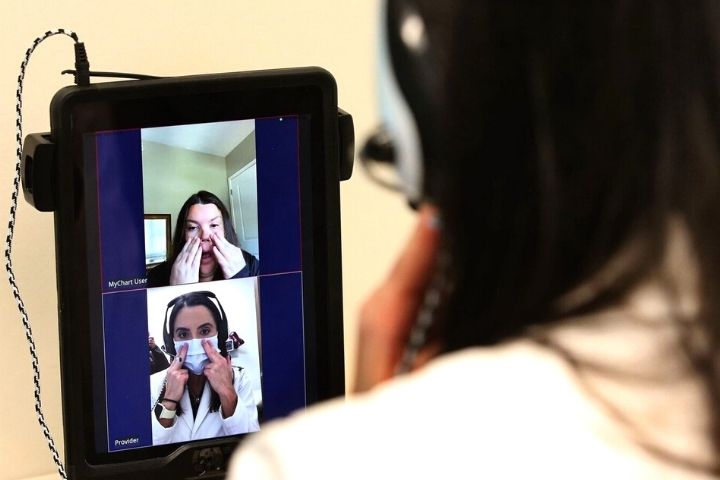The need for telemedical services spiked during Covid-19 related lockdowns as patients’ health concerns kept rising. Nowadays, medical professionals have the unprecedented opportunity to connect with their patients through digital channels and still offer high-quality medical care. As telemedicine slowly but surely gains a status or a recognized alternative healthcare delivery option in many countries, questions about its advantages and disadvantages remain.
From my experience working in a bespoke software development company, I know the importance of tech solutions for today’s business development. No matter the business area, our increasingly digitized society requires simple, convenient and reliable solutions that make our lives easier to navigate. Especially during a global pandemic, mobile health apps and other telemedical services have a significant impact on how people choose and visit medical doctors.
It is normal that each new emerging trend has its supporters and opponents. This article provides an overview of the main pros and cons of the telemedical boom during the pandemic.
Telemedicine In A Nutshell
To begin with, let’s first explain what constitutes telemedicine and why its surged was natural during the Covid-19 pandemic. Telemedicine represents a remote healthcare delivery alternative and enables doctors to practice medicine at a distance. They can examine, monitor and consult patients from anywhere using a stable internet connection and available digital infrastructure, e.g. a mobile app or a web platform.
Telemedical services can be offered both as a primary doctor’s visit and as an additional service after a face-to-face doctor appointment. Depending on the described symptoms, doctors’ availability and urgency, platforms navigate their users and automatically schedule an appointment with a clinician. This can happen with the help of chatbots, virtual assistants or using a hotline. It all narrows down to the main aspects of automating processes, providing accessibility and increasing convenience.
Top Pros Regarding Telemedicine
-
More Accessible Healthcare
Covid-19 showed us just how vulnerable is our global healthcare system. Within days national governments had to re-establish the whole healthcare sector and adopt emergency policies with explicitly defined priorities. It all revolved around the coronavirus, which neglected other patients’ with serious health conditions such as cancer, diabetes or cardiovascular diseases.
The patient-centred approach is currently reshaping heathcare. Digital solutions are the new normal and healthcare providers need to ensure their patients receive equal access to telemedical services. Even in leading economies such as the USA, the UK or Germany, there are still vulnerable groups such as people with disabilities, elderly or remote-living individuals who have difficulties accessing healthcare. Telemedicine offers a solution to transform healthcare by making it more accessible to the broader public.
-
Improved Patient Engagement
One of the crucial aspect that physicians need to pay attention to is patient engagement, as it is vital for treatment outcomes. A doctor-patient relationship has its roots in mutual trust and cooperation, but it thrives as patients’ engagement increases. From a patient’s perspective, admitting that personal responsibility is an essential part of recovery and a healthy lifestyle is critical.
Thankfully, during the pandemic, it became clear that technology can be a powerful asset that boosts patients’ engagement. As modern individuals, we crave on-demand solutions that bring us additional value and provide a highly personalized user experience. Here, telemedicine’s true potential hides many future-oriented ideas such as instant direct payments, a well-organized care continuum and seamless digital interactions with real-life implications.
-
Reduced Operational Costs
If you opt for telemedicine, you usually get the same service quality for a lower price. Medical providers can save lots of operational costs including rent, personal hygiene supplies, expensive equipment or transportation costs when they switch to telemedicine. This will not only save medical practitioners a lot of time, but it will also allow them to concentrate on the most important aspects of their jobs – attentive listening for information of the patient’s medical history or providing them with individualized health advice.
Telemedical services also reduce patient’s costs. For instance, US citizens on average pay less for using telemedicine than when they see their doctor in person. When telemedical services become even more widespread, their costs are expected to drop further, making them more accessible to patients.
The Cons Related To Telemedicine
-
Insurance Coverage And Reimbursements
One of the huge remaining disadvantages of telemedicine is that lots of national governments and private insurers deny reimbursement or only partially cover telemedicine as recognized healthcare delivery. With the ever-rising interest in such innovative solutions, it is expected that more public and private insurance companies will include them and reimburse patient’s costs just as an ordinary in-person appointment.
On the macro level, the global telehealth guide delivers valuable information regarding the status and limitations of telemedical adoption across the world. The report summarizes important finding and mentions to what extent do public healthcare systems and private insurers cover telemedicine. For example, since 2018 the public health system in France covers video consultations and regards them as equal to face-to-face visits, whereas in Japan coverage is currently restricted to pediatrics and lifestyle-related health conditions.
-
Data-Protection Concerns
We know that sensitive personal data is a lucrative target for online hackers and criminals. These can easily do harm if they can access personal electronic medical records. Nor to mention that if medical data leaks, it damages the reputation and public image of a company and can lead to them running out of business.
That is why it is absolutely essential for healthcare providers to invest in reliable partners who will make your solution compliant with the highest industry regulations through advanced encryption standards (AES) and privacy-preserving measures like privacy by design software development and secret computing.
-
Lack of Physical Contact
Due to its nature, telemedicine essentially lacks personal face-to-face contact between patients and healthcare professionals. During virtual appointments, doctors must rely on patient self-reports which might not be 100% accurate.
This will require physicians to ask further questions regarding symptoms in order to get the full picture. Another potential drawback is that if a patient forgets to mention an important symptom that would have been visible during an in-person visit, treatment can be jeopardized or it will need adjustments, which can potentially delay the recovery period.












Leave a Reply